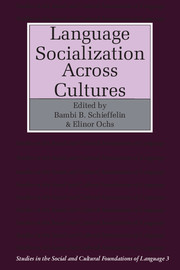1 - Introduction
Published online by Cambridge University Press: 05 June 2012
Summary
Socialization
Socialization has been defined in a variety of ways, each reflecting theories of the individual and society. According to Wentworth (1980), theories of socialization have swung back and forth in terms of the role assigned to the individual in the process of becoming a member of society. Nineteenth-century theories followed Hobbes's notion of the individual as aggressive, selfish, and asocial by nature and saw socialization as the process of reshaping these natural impulses into pro-social feelings and desires (Ross 1896). Freudian theory in the early twentieth century also emphasized conflict between human nature (the id) and society (the superego) (Freud 1960). Then, with the rise of functionalism in the work of Parsons (1937, 1951) and Merton (1949), the individual is viewed as more passive and more socially directed. Through the process of socialization, individuals internalize the values of society, including those relating to personality and role behavior.
George Herbert Mead's theory of symbolic interactionalism (1956) also emphasized the impact of society on an individual's view of “self”; individuals' perceptions of themselves are influenced by how interactional partners see them and treat them. However, for Mead, the individual is an active agent in his own socialization throughout life; individuals do not automatically internalize how others see them and the rest of the world but rather have the capacity to select images and perspectives. In this sense, individuals and society construct one another through social interaction.
- Type
- Chapter
- Information
- Language Socialization across Cultures , pp. 1 - 14Publisher: Cambridge University PressPrint publication year: 1987
- 23
- Cited by



